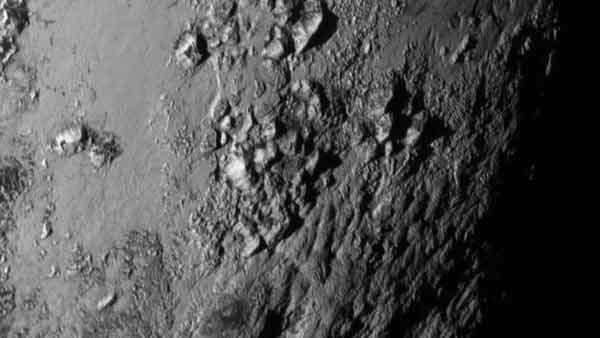
California, US (BBN)-Pluto has mountains made of ice that are as high as those in the Rockies, images from the New Horizons probe reveal.
They also show signs of geological activity on Pluto and its moon Charon, reports BBC.
On Wednesday, scientists presented the first pictures acquired by the New Horizons probe during its historic flyby of the dwarf planet.
The team has also named the prominent heart-shaped region on Pluto after the world's discoverer Clyde Tombaugh.
The spacecraft sped past the dwarf planet on Tuesday, getting as close as 12,500km and grabbing a huge volume of data.
Mission scientist John Spencer told journalists that the first close-up image of Pluto's surface showed a terrain that had been resurfaced by some geological process - such as volcanism - within the last 100 million years.
"We have not found a single impact crater on this image. This means it must be a very young surface," he said.
This active geology needs some source of heat. Previously, such activity has only been seen on icy moons, where it can be explained by "tidal heating" caused by gravitational interactions with a large host planet.
"You do not need tidal heating to power geological activity on icy worlds. That's a really important discovery we just made this morning," said Dr Spencer.
Alan Stern, the mission's chief scientist commented: "We now have an isolated, small planet that's showing activity after 4.5 billion years."
Prof Stern said the discovery would "send a lot of geophysicists back to the drawing boards".
This same image shows mountains at the edge of the heart-like region that are up to 11,000ft (3,300m) high and which team members compared to North America's Rocky Mountains.
John Spencer said the relatively thin coating of methane, carbon monoxide and nitrogen ice on Pluto's surface was not strong enough to form mountains, so they were probably composed of Pluto's water-ice bedrock.
"Water-ice at Pluto temperatures is strong enough to hold up big mountains," he said.
The thin frosting of nitrogen and other volatiles on top of water-ice bedrock was intriguing, said Prof Stern, because Pluto's tenuous, mainly nitrogen atmosphere was constantly being lost to space.
He recently co-authored an academic study with colleague Dr Kelsi Singer making some predictions based on such a scenario.
"What Kelsi and I predicted was that if we saw steep (water-ice) topography on Pluto with only a volatile veneer, there must be internal activity that's dredging nitrogen up through cryo-volcanism or geysers or some other process that's active into the present on this planet," the mission's chief scientist explained.
"We haven't found geysers and we haven't found cryovolcanoes, but this is very strong evidence that will send us looking."
IN MEMORIAM
Scientists have named the heart-shaped region Tombaugh Regio, after the astronomer who discovered Pluto in 1930.
The new, close-up image of Charon has revealed a chasm 4-6 miles deep and also further evidence of active resurfacing.
"Originally I thought Charon might have an ancient terrain covered in craters... it just blew our socks off when we had the new image," said Dr Cathy Olkin.
"Going from the north-east to the south-west is a series of troughs and cliffs...they extend about 600 miles across the [moon]. It's a huge area and it could be down to internal processing."
A striking dark region at the moon's pole may be a thin veneer on top of redder material, she added. It has been informally named Mordor, after the region in the fictional land of Middle Earth in Tolkien's Lord of the Rings books.
The first well resolved picture of Pluto's small moon Hydra reveals an elongated body with a surface predominantly made of water-ice. In addition, scientists have come up with a good estimate for its size: 43km by 33km.
"Hydra is not a planet," team member Hal Weaver joked.
The snap contains only a few pixels because the moon is so small and distant; New Horizons took the shot from a distance of 400,000 miles (650,000km).
The pictures were sent back to Earth during the course of two data downlinks on Wednesday.
Significantly, all these images are at a much higher resolution than anything we have seen so far.
The mission team has told New Horizons this week to send down only a small fraction of the total data it carries.
Part of the reason is that the probe continues to do science, observing Pluto from its night side.
The intention is to keep looking at it for about two more full rotations, or 12 Earth days.
BBN/SK/AD